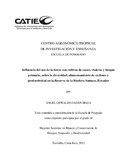Influence of land use with cocoa crops, chakras and primary forest on diversity, carbon storage and productivity in Sumaco Biosphere Reserve, Ecuador
Alternative title
Influencia del uso de la tierra con cultivos de cacao, chakras y bosque primario, sobre la diversidad, almacenamiento de carbono y productividad en la Reserva de la Biosfera Sumaco, Ecuador
Description
Tesis (Mag.Sc.) -- CATIE, 2012
Abstract
La investigación se realizó en la Reserva de la Biosfera Sumaco, en la provincia del Napo, Republica del Ecuador. Se estudiaron siete sistemas de uso de la tierra: Chakras con y sin sombra, cultivos de cacao propagados por semilla con y sin sombra, cacao injertado con y sin sombra y bosque primario. Se evaluaron tres variables de respuesta: diversidad arbórea y arbustiva, almacenamiento-acumulación de carbono (C) y productividad, en los diferentes sistemas de usos de la tierra. Según los índices de Shannon, Simpson y α Fisher, el bosque primario es el más diverso con respecto a los sistemas agrícolas con sombra. De acuerdo con el índice de equitatividad todos los sistemas agrícolas son iguales. Los sistemas de uso agrícola no presentan diferencias significativas ∞ =0.05 considerando todos los índices evaluados. La combinación entre los sistemas cacao semilla e injerto con sombra resultó ser la que mayor cantidad de especies conserva con 23.6 especies ha-1. También son los sistemas que mayor cantidad de C almacena con 153.4 Mg C ha-1. Referente a las tasas de acumulación de stocks de C en unidades de CO2e, los sistemas mencionados poseen los máximos valores con 20.2 Mg CO2 ha-1 año-1, lo que significa monetariamente ingresos potenciales de 101.2 USd ha-1 año-1. Los sistemas cacao semilla sin sombra y cacao semilla con sombra son los que presentan mayores ingresos potenciales por la venta de C y también por productividad con 2 370.5 USd ha-1 año. The research was conducted in Sumaco Biosphere Reserve in the province of Napo, Republic of Ecuador. We studied seven systeMON of land use: Chakras with and without shade, cocoa crops propagated by seed with and without shade, cacao grafted with and without shade and primary forest. We evaluated three response variables: tree and shrub diversity, storage-accumulation of carbon (C) and productivity in the different systeMON of land use. According to Shannon, Simpson, and α Fisher indexes, the primary forest is the most diverse with respect to agricultural systeMON with shade. According to the Equitability index all systeMON are equal. Agricultural systeMON are not significantly different ∞ = 0.05 considering all indexes evaluated. The combination between cacao seed and grafting shaded systeMON proved to be the most number of species preserved with 23.6 species ha-1. SysteMON are also greater quantity of carbon stored with 153.4 Mg ha-1. Regarding the rates of C stock accumulation in units of CO2e, the above systeMON have the highest CO2 values with 20.2 Mg ha-1 yr-1, which means monetarily potential income of US 101.2 ha-1 yr-1. Cocoa seed shaded and cocoa seed unshaded systeMON are those with the highest potential income from C sale and also productivity with US 2 370.5 ha-1 yr-1.
Keywords
Publisher
CATIE, Turrialba (Costa Rica)
URI (Permanet link to cite or share this item)
https://repositorio.catie.ac.cr/handle/11554/5241http://orton.catie.ac.cr/repdoc/A8957e/A8957e.pdf
Collections
- Tesis [3046]


